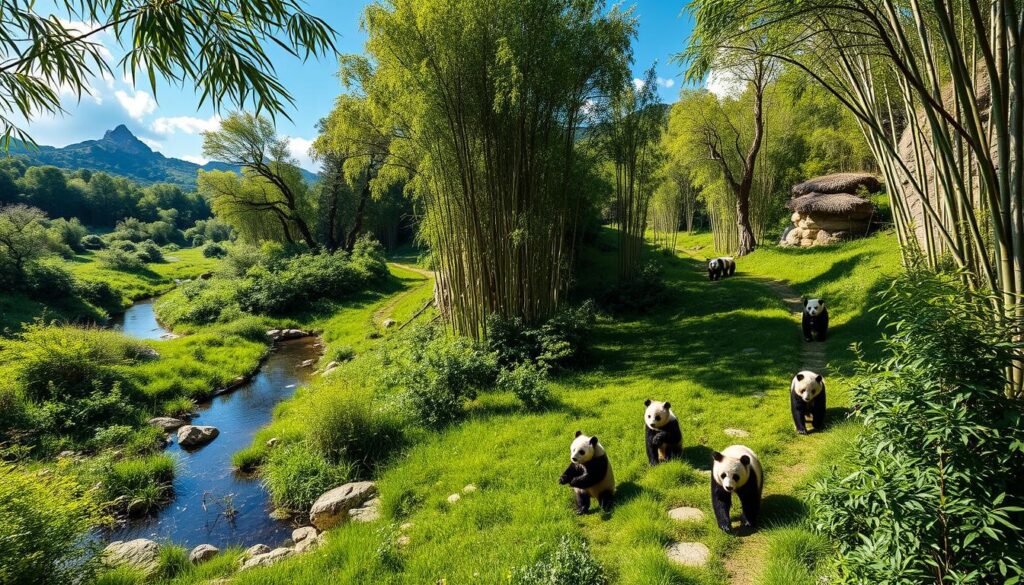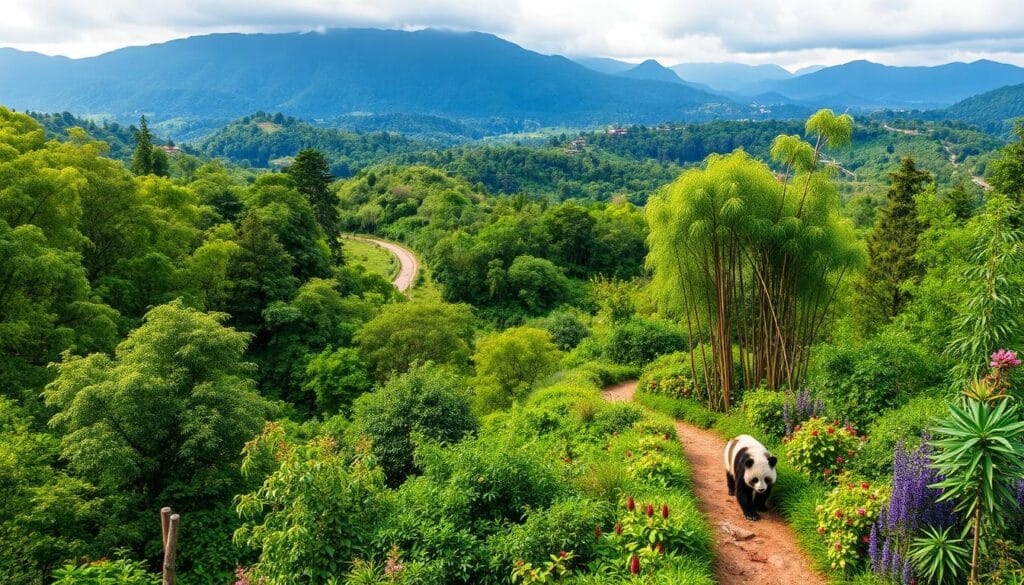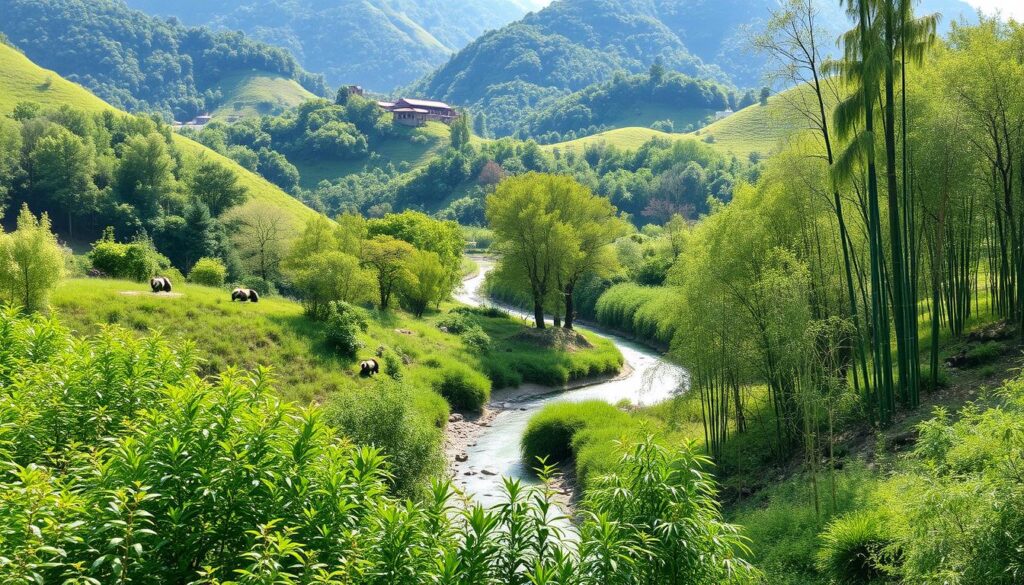The good news is that giant panda numbers are on the rise. This is thanks to successful conservation efforts. Yet, pandas still face dangers like habitat loss and fragmentation. So, more work is needed to ensure their survival and growth.
Creating new reserves and linking existing panda populations is crucial. The Chinese government, working with WWF, has made bamboo corridors. These connect forest pockets, letting pandas move, find food, and meet mates.
Human development has fragmented panda habitat. More wildlife corridors are needed to connect isolated panda groups. These corridors give pandas and other animals a safe way to travel between separated habitats.
Key Takeaways
- Wildlife corridors are essential for protecting and conserving panda populations by linking fragmented habitats.
- Creating new reserves and connecting existing panda populations are critical for the species’ long-term survival.
- The Chinese government has developed bamboo corridors to help pandas move, find food, and breed more successfully.
- Additional wildlife corridors are needed to connect isolated panda populations and provide safe passage for pandas and other wildlife.
- Protecting and restoring wildlife habitat connectivity is crucial for the recovery and conservation of panda and other wildlife species.
Understanding the Importance of Wildlife Corridors
Wildlife corridors are key for saving biodiversity. They let animals safely travel between broken habitats. This way, they can find the food and shelter they need to live well.
These paths are vital in fighting habitat loss. Habitat loss is a big problem for many animals around the world.
Habitat Fragmentation: A Major Threat to Wildlife
Habitat loss, caused by human activities, harms many animals. When habitats get split up, animals struggle to find food, water, and shelter. They also face more dangers from predators and the environment.
This can cause animals to disappear from certain areas. It also leads to a decrease in biodiversity.
National wildlife refuges are important for keeping wildlife corridors safe. They help animals like birds, fish, and mammals. For example, elk, mule deer, and pronghorn travel long distances between their winter and summer homes.
In 2019, the Department of the Interior gave $2.1 million to protect these corridors in Western states.
- Wildlife refuges are crucial for migrating birds on the nation’s main flyways.
- Projects like at Tualatin River National Wildlife Refuge help fish like cutthroat trout and Coho salmon.
- Monarch butterflies migrate up to 3,000 miles, facing challenges like milkweed loss due to development.
By making and keeping wildlife corridors, we help animals move safely. This boosts biodiversity and helps them adapt to our changing climate.
The Role of Wildlife Corridors in Panda Conservation

Creating ecological corridors in western China has been key to saving the giant panda. These paths connect the broken habitats of wild giant pandas. They let different subspecies meet and breed, boosting the genetic diversity of the population.
It’s important to reduce human impact and restore the natural forest habitat. This habitat should have bamboo and plants that produce berries. Without these, the 33 regional subspecies of giant pandas face a high risk of extinction.
“The ecological corridors established in west China have connected fragmented habitats of wild giant pandas, expanding their habitat range and facilitating the hybridization among different subspecies.”
The article “Giant pandas in a changing landscape” stresses the need for conservation. It points out the decline in giant panda numbers due to habitat loss. Another study, “Conservation Implications of Drastic Reductions in the Smallest and Most Isolated Populations of Giant Pandas,” shows the urgent need to protect the smallest and most isolated populations.
Wildlife corridors are crucial for giant panda conservation. They provide a safe way for pandas to move between broken habitats. This helps protect the species and ensures they can adapt to climate change and maintain their genetic diversity.
Wildlife Corridors: Facilitating Panda Movement and Hybridization

Wildlife corridors are key for giant pandas’ movement and genetic diversity. Their former vast habitat is now split by human development. Ecological corridors connect these areas, helping pandas from different subspecies to migrate and interbreed.
This reduces inbreeding and boosts panda populations’ resilience. Footage shows pandas using these corridors, highlighting their importance. These paths help not just pandas but also other wildlife, like black bears and mule deer.
China’s conservation efforts for giant pandas include these corridors. The 22,000 square km Giant Panda National Park in Sichuan province is a major focus. China has invested 374 million yuan (about $59 million) in six ecological corridors.
This work aims to reconnect 33 regional panda subspecies. Twenty-four of these are at risk due to small, isolated populations. The corridors ensure pandas’ survival and adaptability in a changing climate.
Wildlife corridors benefit more than just giant pandas. They offer safe passage for many species. As we face habitat loss and fragmentation, preserving these corridors is vital for biodiversity and ecosystem resilience.
China’s Efforts in Establishing Wildlife Corridors

China has made big steps in creating wildlife corridors to protect its plants and animals. In Sichuan province, six ecological corridors were set up, costing 374 million yuan. The government even gave up a hilltop road for the giant pandas.
New railway and expressway lines have tunnels to avoid pandas’ habitats. This shows China’s dedication to wildlife.
The Giant Panda National Park
China’s work goes beyond just corridors. It has created five national parks, including the Giant Panda National Park. This park covers 22,000 square kilometers in Sichuan, Shaanxi, and Gansu provinces.
These corridors help giant pandas and other animals like black bear and mule deer. They keep genetic diversity alive, ensuring these species survive for a long time.
Recently, 85% of key wildlife populations in 35 biodiversity conservation priority areas have been established in China. China aims to protect one-quarter of its land. The Chinese ecological conservation redline protects sensitive habitats and ecosystems.
The Ministry of Ecology and Environment has given guidelines for identifying these redlines. China uses the Three Control Lines in planning to balance development and nature. These efforts show China’s strong commitment to its natural heritage and wildlife.
Also Read : Sustainable Agriculture For Panda: Eco-Friendly Farming
Conclusion
Wildlife corridors are key to protecting pandas by linking broken habitats. They help pandas move and mix with other subspecies. The Chinese government has worked hard to create these paths, like stopping roads and building tunnels.
These efforts help pandas and other animals too. It’s important to keep these paths safe for all wildlife. This way, we can fight against habitat loss, climate change, and human activities.
We need to keep working together to save these corridors. Governments, groups, and local people must join forces. By doing this, we can make sure pandas and other animals have a safe home for a long time.
FAQs
Q: What is the importance of connectivity in wildlife corridors for panda populations?
A: Connectivity in wildlife corridors is crucial for panda populations as it allows for safe movement between habitats, enabling them to find food, mates, and genetic diversity, which is essential for their survival.
Q: How do wildlife crossing projects improve wildlife movement for pandas?
A: Wildlife crossing projects, such as underpasses and overpasses, improve wildlife movement by providing safe passage for wildlife, reducing the risk of collision with vehicles on highways, and facilitating the dispersal of pandas across fragmented habitats.
Q: What action plan can be implemented to support wildlife corridors for pandas?
A: An effective action plan to support wildlife corridors for pandas may include creating protected areas, restoring degraded habitats, implementing wildlife crossing structures, and engaging in community education about the importance of wildlife conservation.
Q: What types of animals use wildlife corridors besides pandas?
A: Many animals use wildlife corridors, including species that require large territories for foraging and breeding, such as deer, bears, and various reptiles and amphibians, which also benefit from these important wildlife corridors.
Q: How do barriers, like highways and fences, affect wildlife movement in panda habitats?
A: Barriers such as highways and fences can significantly hinder wildlife movement in panda habitats, isolating populations and increasing the risk of collision. This can lead to a loss of genetic diversity and make it difficult for pandas to find mates and resources.
Q: What are some examples of wildlife crossing structures that help protect panda populations?
A: Examples of wildlife crossing structures that help protect panda populations include underpasses, overpasses, and culverts, which allow animals to cross safely beneath or above roads, thereby reducing the risk of collision and facilitating wildlife movement.
Q: How do rivers and streams play a role in wildlife corridors for pandas?
A: Rivers and streams often serve as natural corridors that can connect different panda habitats, allowing for easier movement and dispersal. These waterways can be critical for the survival of many species, including pandas, by providing essential resources and reducing the impact of barriers.
Q: What is the impact of the loss of wildlife corridors on panda populations?
A: The loss of wildlife corridors can have a devastating impact on panda populations by fragmenting their habitats, limiting their access to food and mates, and increasing the risk of inbreeding, which can threaten their long-term survival.
Q: How can local departments of transportation contribute to wildlife conservation for pandas?
A: Local departments of transportation can contribute to wildlife conservation for pandas by incorporating wildlife crossing projects into road planning, maintaining habitat corridors, and ensuring that new roads minimize the impact on panda populations and their habitats.

